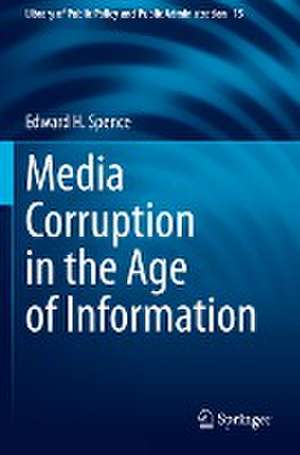Media Corruption in the Age of Information: Library of Public Policy and Public Administration, cartea 15
Autor Edward H. Spenceen Limba Engleză Paperback – 23 mai 2022
This book provides an applied model of corruption to identify, analyse, and assess the ethics of major types of corruption in the media involving practices such as cash-for-comment, media release journalism, including video news releases (VNRs), fake news, deep fakes, and staged news. The book starts with a conceptual philosophical analysis of corruption in general, followed by an in-depth analysis of media corruption, across its various transformations, from the legacy media of the 4th Estate (e.g. The UK Guardian) to the digital media of the 5th Estate (e.g. Social Media and Wikileaks) to the Network Media of the 6th Estate (e.g. Facebook and Google), and provides key case studies as practical illustrations and contextualisation of those major types of media corruption. It explains how the conversion of the two forms of media communication, corporate and social digital communication, as expressed in the symbiotic relationship between the 4th Estate and the 5th Estate exposes andenables the reporting of corruption, signalling a major shift in the way the media itself can provide an effective means for anti-corruption measures against major practices of corruption that would have otherwise gone unnoticed.
| Toate formatele și edițiile | Preț | Express |
|---|---|---|
| Paperback (1) | 694.55 lei 6-8 săpt. | |
| Springer International Publishing – 23 mai 2022 | 694.55 lei 6-8 săpt. | |
| Hardback (1) | 730.47 lei 6-8 săpt. | |
| Springer International Publishing – 22 mai 2021 | 730.47 lei 6-8 săpt. |
Din seria Library of Public Policy and Public Administration
-
 Preț: 114.20 lei
Preț: 114.20 lei -
 Preț: 397.59 lei
Preț: 397.59 lei - 15%
 Preț: 640.88 lei
Preț: 640.88 lei - 18%
 Preț: 967.22 lei
Preț: 967.22 lei - 18%
 Preț: 895.58 lei
Preț: 895.58 lei -
 Preț: 384.31 lei
Preț: 384.31 lei -
 Preț: 391.61 lei
Preț: 391.61 lei - 15%
 Preț: 698.15 lei
Preț: 698.15 lei - 18%
 Preț: 725.92 lei
Preț: 725.92 lei - 18%
 Preț: 951.47 lei
Preț: 951.47 lei - 15%
 Preț: 635.31 lei
Preț: 635.31 lei - 18%
 Preț: 949.10 lei
Preț: 949.10 lei - 15%
 Preț: 639.08 lei
Preț: 639.08 lei - 15%
 Preț: 642.51 lei
Preț: 642.51 lei - 15%
 Preț: 646.94 lei
Preț: 646.94 lei - 15%
 Preț: 646.43 lei
Preț: 646.43 lei - 15%
 Preț: 640.06 lei
Preț: 640.06 lei
Preț: 694.55 lei
Preț vechi: 817.12 lei
-15% Nou
Puncte Express: 1042
Preț estimativ în valută:
132.90€ • 139.26$ • 109.87£
132.90€ • 139.26$ • 109.87£
Carte tipărită la comandă
Livrare economică 11-25 aprilie
Preluare comenzi: 021 569.72.76
Specificații
ISBN-13: 9783030616144
ISBN-10: 3030616142
Ilustrații: X, 235 p. 1 illus.
Dimensiuni: 155 x 235 mm
Greutate: 0.35 kg
Ediția:1st ed. 2021
Editura: Springer International Publishing
Colecția Springer
Seria Library of Public Policy and Public Administration
Locul publicării:Cham, Switzerland
ISBN-10: 3030616142
Ilustrații: X, 235 p. 1 illus.
Dimensiuni: 155 x 235 mm
Greutate: 0.35 kg
Ediția:1st ed. 2021
Editura: Springer International Publishing
Colecția Springer
Seria Library of Public Policy and Public Administration
Locul publicării:Cham, Switzerland
Cuprins
Chapter 1: Introduction3; Chapter 2 The Tree of Knowledge: The Normative Structure of Information.- Chapter 3 The Serpent’s Lair - Characteristics, Causes and Contexts of Corruption.- Chapter 4 Media Corruption -Types, Causes and Contexts.- Chapter 5 Tech Media Corruption in the Age of Information.- Chapter 6 Investigative Journalism - the Serum Against the Snake’s Bite.- Chapter 7 Public Policy and Regulative Change to Combat Media Corruption.- Epilogue - Knowledge to Wisdom in the Age of information.- Bibliography.- Appendix 1:The Myth of Gyges.- Appendix 2: The Allegory of the Cave.
Notă biografică
Dr. Edward Howlett Spence is a Research Affiliate in the Department of Philosophy, University of Sydney and Adjunct Senior Lecturer, Charles Sturt University in Australia, and Research Fellow at the 4TU Centre for Ethics and Technology in the Netherlands. Spence received his PhD in Philosophy from the University of Sydney. His main areas of research are moral philosophy, professional and applied ethics, and philosophy and ethics of technology.
Textul de pe ultima copertă
This book provides an applied model of corruption to identify, analyse, and assess the ethics of major types of corruption in the media involving practices such as cash-for-comment, media release journalism, including video news releases (VNRs), fake news, deep fakes, and staged news. The book starts with a conceptual philosophical analysis of corruption in general, followed by an in-depth analysis of media corruption, across its various transformations, from the legacy media of the 4th Estate (e.g. The UK Guardian) to the digital media of the 5th Estate (e.g. Social Media and Wikileaks) to the Network Media of the 6th Estate (e.g. Facebook and Google), and provides key case studies as practical illustrations and contextualisation of those major types of media corruption. It explains how the conversion of the two forms of media communication, corporate and social digital communication, as expressed in the symbiotic relationship between the 4th Estate and the 5th Estate exposes and enables the reporting of corruption, signalling a major shift in the way the media itself can provide an effective means for anti-corruption measures against major practices of corruption that would have otherwise gone unnoticed.
Caracteristici
First systematic theoretical study on the how and why of media corruption Provides up-to-date illustrative cases of corruption with regard to the corporate and digital media Enables the formulation and implementation of anti-corruption policies and controls for regulation In-depth analysis and illustrative case studies enables the identification and ethical assessment of issues arising in media corruption
